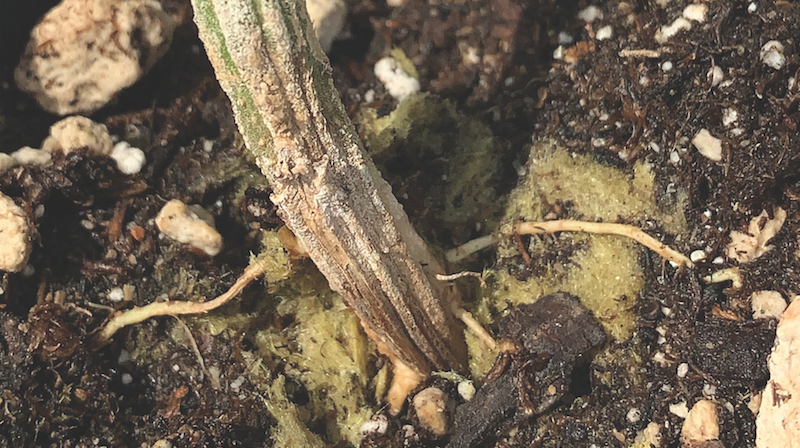
How to Protect Indoor Cannabis Crops from Infections
Marijuana (Cannabis sativa L.) is susceptible to several Fusarium and Pythium species that infect the roots and stems at transplant and throughout the vegetative phase. Recent research conducted by Punja et al. 2019 has identified three Fusarium species and three Pythium species including: Fusarium oxysporum, F. solani, F. brachygibbosum, Pythium dissotocum, P. myriotylum and P. aphanidermatum.
Symptoms include root discoloration and rot as well as lower stem rot that often lead to death of the plant called “damping off” (pictured above). Above ground the cannabis plants often show yellowing of the leaves, stunting and general leaf wilt even if root zone has been properly irrigated.
In general, most cannabis root and stem rots occur between transplanting of the newly rooted clones and the first three weeks of vegetation as the young plant tissue is most susceptible. Once the cannabis plant establishes a more mature root system and thicker stems it is less likely to succumb to damping-off by Fusarium and Pythium and often the plant can grow out of an existing infection. The single biggest factor to influence whether your young cannabis plants get infected by these root rot organisms is a water-logged root system. Overly continuous wet soils starve the root zones of oxygen and weaken the health of the young cannabis plant, thus increasing the susceptibility to fungal infection.
Pythium is referred to as a fungal-like organism or water mold. Unlike true fungi, Pythium differ in mycelium structure and that they produce oospores inside the roots and zoospores that can swim in water. These water molds thrive in persistent wet soils, hydroponic media, plant debris and recirculating systems.
Fusarium is a large group of pathogenic and saprophytic fungi that are economically important due to their devastating impact on crops. The Fusarium fungi can be found in the soil, plant debris and plant stems including mother plants, which can act as a long-term host and source of mycelium and spore inoculum. The fungus produces abundant spores that can spread to other plants via contaminated tools, soil, water and air.
Prevention and Control
1. Keep grow rooms clean of soil and plant debris as these can harbor Pythium and Fusarium mycelium and spores.
2. Disinfect grow room surfaces periodically as well as pots and tools before reusing them. Bleach, H2O2 and products that contain peroxyacetic acid (PAA) like Jet-Ag* work well. The PAA and H202 materials can also be used as a periodic root drench to disinfect the grow medium as well as a disinfecting spray for the leaves and stem.
3. Clean air of fungal spores through high-quality air filtration units. This will also help with other important cannabis fungal diseases including powdery mildew and Botrytis bud rot. UV-C disinfection units and high-quality air filters are becoming standard in cannabis production.
4. Maintain proper soil moisture in the root zone and — more importantly — avoid water logged conditions that lead to low oxygen levels. The addition of perlite to your peat moss or coco coir media will increase the air spaces and drainage of your root zones. Rock wool is an ideal growing media since it is sterile and contains high amounts of airspaces even when fully irrigated.
5. Proper fertilization and pH will enhance plant health and its ability to fend off diseases naturally. Young cannabis plants that are under fertilized are weak and are more susceptible to pathogenic and environmental stressors. Conversely, over fertilization can lead to high salt concentrations in the soil and thus can be toxic to roots and the leaves exhibit nutrient imbalances and burn. The addition of soluble silicon like potassium silicate (K2SiO3) can enhance that plants ability to resist diseases and insects as well as environmental stressors like heat, cold and drought.
6. Inoculation of the root zone with beneficial organisms like mycorrhizae, Bacillus, Trichoderma and Streptomyces species can help prevent Fusarium and Pythium infections and increase root and plant health to better defend against disease. Regalia CG* is a popular biofungicide that increases the cannabis plant’s own defense mechanisms and increases root and plant health to prevent root and stem rots, powdery mildew, and Botrytis bud rot.
Follow these easy to implement preventative and curative measures and you will be on your way to healthy, disease-free cannabis plants that will grow up and produce high-quality flower.
Matthew Brecht is cannabis key account manager with Marrone Bio Innovations and can be reached at mbrecht@marronebio.com. Visit www.marronebio.com for more information on how to control cannabis pests and establish production protocols.



